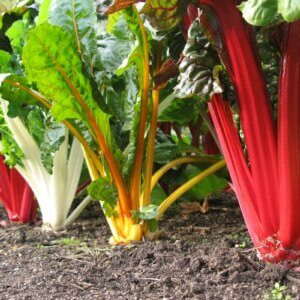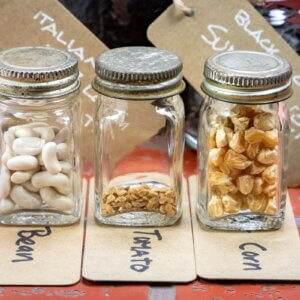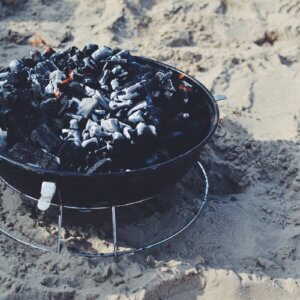I have been on the hunt for a good granola recipe for years, and when I mean “good” granola recipe, I mean something that doesn’t taste like caramel with a few odd oat bits as pretense for health food. After healing my taste buds from the over influence of sugar so common in processed food, I found that I couldn’t eat store-bought granola anymore.

Truly. After glancing at the sugar content, it was obviously just candied oats masquerading as a health food. No matter how it was packaged, that stray raisin and a sprinkle of chia seeds couldn’t negate an overabundance of sugar (or honey, or brown rice syrup, or however many different epithets they gave sugar to hide its presence). So with a bold face, I ventured into my kitchen, and set about making my own tasty, low-as-possible-sugar granola clusters.
I then made a lot of disappointing granola. It couldn’t even be called granola, honestly.
You see, the huge amount of sugar used in normal granola recipes is necessary to bind the ingredients into those delectably crunchy, oaty clusters. Take out all or most of the sugar, and you end up with toasted oat flakes and slightly burned cinnamon floating around the bottom of the pan.
At first, I resigned myself to being stuck. I gave up sharing granola with others (something I had done in my sugar-consuming days) and generally lost my zest for eating it.
But then I experimented and discovered a secret that changed everything. The addition of one common ingredient yielded granola that was full of flavor, plenty sweet without being candy-sweet and, best of all, made the delightfully crunchy clusters that I had never been able to achieve without the candying action of the sugar.
You know this ingredient well, even though it’s not really valued. It appears in lunchboxes, countertops, or forgotten corners of the car, and spends most of the time attracting fruit flies: The dreaded overripe banana. Too sickly sweet to eat, they sulk in their soggy brown spots, knowing there is only one fate left for them. A freezer bag, with those rarely-fulfilled promises of future banana bread (or forlornly tossed in the garbage, compost heap, or chicken coop).

At least, that’s how it is in many homes. But in this article, I hope to share with you how to make homemade low-sugar granola that not only blows store-bought granola out of the water, but gives new life to the ubiquitous, underappreciated, overripe banana. Now that’s what I call a win-win.
Basic Granola Recipe
This granola uses the starchy, naturally-sweet pulp of mashed bananas (or plantains) to bind together and sweeten the oats perfectly. Strangely, even though it uses a lot of bananas, the resulting granola isn’t overly banana-y tasting, making it perfect to bend to whatever flavor you may invent or desire. As you read through the instructions, you may notice this recipe requires more time than the usual granola. I make granola in “passive” oven time, when my heated oven is cooling down after cooking some other dish. As such, my personal granola endeavors typically take two days from start to finish. You can, however, get this recipe done in around two hours if you are monitoring it.
This recipe also is good for making delicious granola clusters. After cooling, you can create any range of granola mixes you want with the inclusion of nuts, seeds, spices, and dried fruits. I’ve listed some recommended mixes, but you can make whatever your heart desires.
Ingredients
- 6 cups oats
- 1 cup coconut
- 3 tablespoons ground flaxseed (optional, but aids in binding the clusters)
- 1½ teaspoons cinnamon
- 1 teaspoon vanilla extract
- 1/2 teaspoon salt
- 3 overripe bananas, or 1 overripe banana and 1 overripe plantain, or two overripe plantains
- 1/4 cup coconut oil or butter
- 1 tablespoon honey or maple syrup (optional, but pleasant)
- Water (amount will vary)
Yields roughly 8 cups of granola without inclusions.

Steps
- If using a conventional oven, preheat to 325 degrees Fahrenheit. If using a wood cookstove (hey, fellow weirdo!) you can fully cook this granola in the ambient heat created by your firebox without directing the heat to warm the oven.
- In your largest bowl, combine oats, coconut, flaxseed, cinnamon, vanilla, and salt. Mix thoroughly.
- Meanwhile, in a second bowl, combine honey or syrup, melted oil or butter, mashed banana, or mashed plantain. If using plantains, boil them first in about a third of a cup of water until soft, then mash with the boiling water before mixing with the oil or honey mixture. The resulting slurry should be thoroughly combined.
- Pour the banana mixture over oats and mix well, adding more water as necessary until all the oats have been moistened. The ideal mixture should stick to itself if formed in a ball. If a ball falls apart, add more water.
- Divide the granola between two ungreased baking sheets. With a slightly moist hand, compress the granola in a flat, even layer. This is a crucial step for cluster-formation, so don’t skip it.

- Now, if you’re making this granola in a conventional oven, you’ll want to cook the granola for about 20 minutes — or until the oats begin to slightly brown at the edges of the pan. If you’re using residual heat after cooking something else, you can leave the oats in the oven overnight as it slowly cools — though I would recommend checking the oats after 15 to 20 minutes to make sure they’re not toasting too quickly. The same applies if you’re using the residual heat in a woodstove left over after cooking a meal. I would recommend putting the granola in after the active fire has died down in your combustion chamber, and you’ve been left with a ruby glow. Again, check your oats after about 15 to 20 minutes to make sure they’re only lightly browned. If, at any moment, you smell toasted oats, check them immediately. They may be browning too quickly.

- However long it takes, once your oats are lightly browned on the edges, remove the pans from the oven. Take a spatula (or your hand, if they’ve cooled enough) and break apart the layer of oats in more manageable clusters. You’ll want to make sure you’ve flipped every piece, as the bottom of the layers should be moist.

- Place the pans back in the oven. If you’re heating your oven just for them, cook at 300 degrees Fahrenheit until the clusters are completely, crisply dry. If cooking in residual heat, you’ll probably need to leave them overnight to slowly dry and crisp up. Again, check the oats before you go to bed, just to make sure they’re not overcooking.
- Once the oats are completely dry, toasted, and deliciously fragrant, you can store them in an airtight container. This recipe should fit in a half-gallon mason jar perfectly. You can choose to blend your crunch clusters with the desired inclusions at this point (meaning it will no longer fit in a single half-gallon mason jar). Or if you’re like me, wait until serving to add them on top, and jazz up your granola bowl.
- Serve the granola as-is, mixed in trail mix, topped with yogurt, or with milk like breakfast cereal. I hope you enjoy this recipe and (most of all) have a new use for those overripe bananas.

Inclusion Ideas
These are just my ideas, of course. You can add whatever dried or fresh fruits, nuts, spices, or seeds you like to truly personalize your homemade granola. You can also adjust the main recipe, adding cocoa powder, chia, or sesame seeds, or experimenting with different binders (I have had decent results mixing one mashed overripe banana with an egg). Some alternative fruits are listed in the conclusion below as well.
- Harvest Blend: Pecans, dried apples, a sprinkle of nutmeg
- GORP Blend: Peanuts, raisins, and banana chips
- Native Plants blend: Wild hazelnuts, walnuts, and/or hickory nuts, dried cranberries, and dried blueberries
- Tropical Blend: Cashews, dried mango, dried coconut slices, acai berries
- Not-So-Healthy Banana Split Blend: Dark chocolate chips, pecans, butterscotch chips, banana chips, rainbow sprinkles (if you’re feeling like eating like an 8-year-old again)
I’d love to hear from you if you try out my recipe. Tell me how it worked, what mix-ins were your favorites, and most of all, if overripe bananas now have a special place in your heart as more than just forestalled banana bread. If there are other starchy-sweet fruits in your repertoire, don’t be afraid to give those a try!
Though I haven’t yet tried it, I’m curious how this recipe might work with mashed paw paw (Asimina triloba), persimmon (Diospyros virginiana), apples, pumpkin puree (can we say pumpkin pie granola?) or lesser-known fruits like nannyberry (Viburnum lentago). I imagine anything that could make a good fruit leather could make a great binder for granola. If you give it a shot, let us know in the comments below.










































Leave a Reply